JEWISH NEW YEAR.
 (Rosh Hashanah), the Jewish New Year falls on the first of Tishri, which is the seventh month of the Jewish calendar. Originally, Rosh Hashanah was just a small part of the Autumn harvest festival. The name Rosh Hashanah was not given to the day until after the Bible was completed. 1. Later, when it became a separate festival it rose in importance. It is now one of the Yamim Nora'im (the Awesome Days), it is also referred to in English as part of the High Holy Days. It is therefore one of the days where you may expect to find all religious Jews in Synagogue. For a further explanation please see THE CALENDAR
(Rosh Hashanah), the Jewish New Year falls on the first of Tishri, which is the seventh month of the Jewish calendar. Originally, Rosh Hashanah was just a small part of the Autumn harvest festival. The name Rosh Hashanah was not given to the day until after the Bible was completed. 1. Later, when it became a separate festival it rose in importance. It is now one of the Yamim Nora'im (the Awesome Days), it is also referred to in English as part of the High Holy Days. It is therefore one of the days where you may expect to find all religious Jews in Synagogue. For a further explanation please see THE CALENDAR
(1.) The only time the phrase occurs is in Ezekiel 40, 1, where it refers to the tenth day of the month.
The Jewish New Year is unlike January 1st. Instead of being a day for parties, it is a day of introspection, when we consider that we are now one year older. We therefore stop and think how we are using the limited number of years allotted to us. It is a time of self-judgement in the light of God's teachings. It is the first of Ten days of Penitence, the last of which is  (Yom Kippur), the Day of Atonement. It is therefore a very serious day, when we begin the long process of admitting our wrong doings, repenting of them and seeking forgiveness for them.
(Yom Kippur), the Day of Atonement. It is therefore a very serious day, when we begin the long process of admitting our wrong doings, repenting of them and seeking forgiveness for them.
There are several names for the day:
- The name that is most commonly used is
 (Rosh Hashanah) = the head (beginning) of the year. The name dates back to the time of the Mishnah c.3rd century CE, where the whole Tractate on the festival is given this title.
(Rosh Hashanah) = the head (beginning) of the year. The name dates back to the time of the Mishnah c.3rd century CE, where the whole Tractate on the festival is given this title.
-
 (Yom T'ruah).2. = The day of the sounding of the Shofar. T'ruah is the name of one of the Shofar calls.
(Yom T'ruah).2. = The day of the sounding of the Shofar. T'ruah is the name of one of the Shofar calls.
-
 (Yom Hadin.) = The day of Judgement. (see also UN'TANEH TOKEF.) The day was linked to judgement in the Mishnah.3. The judgement begins but the final seal is not put upon it until the end of Yom Kippur. This phrase is used in the Machzor, the prayer book for the festival days.
(Yom Hadin.) = The day of Judgement. (see also UN'TANEH TOKEF.) The day was linked to judgement in the Mishnah.3. The judgement begins but the final seal is not put upon it until the end of Yom Kippur. This phrase is used in the Machzor, the prayer book for the festival days.
-
 (Yom Hazikaron) 4. =The Day of Memorial (or remembrance). It is for us to remember our past faults and for God to remember us with mercy and forgive us.
(Yom Hazikaron) 4. =The Day of Memorial (or remembrance). It is for us to remember our past faults and for God to remember us with mercy and forgive us.
(2.) Numbers 29, 1. (3.) Rosh Hashanah 1, 2. (4.) Leviticus 23, 23 refers to the day as Zichron T'ruah = A memorial with the blowing of horns.
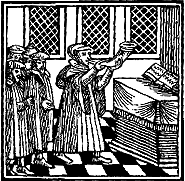
|
Blowing the Shofar
Amsterdam, 1695 |
The highlight of  (Rosh Hashanah) is the sounding of the Shofar. It used to be the general custom to blow the
(Rosh Hashanah) is the sounding of the Shofar. It used to be the general custom to blow the  (Shofar), horn on the first day of each month. But on the first of Tishri, which was a very special month filled with holy days, there was a series of Shofar calls. The Shofar itself could be taken from any clean animal, but they avoided bullocks lest it should remind God of our greatest sin, that concerning the golden calf. It was therefore usually a ram's horn, and was linked with the ram caught by it's horns at the time of the sacrifice of Isaac.5. The Shofar has to be curved to symbolise our willingness to bend and repent before God and not be unbending or stiff-necked.6.
(Shofar), horn on the first day of each month. But on the first of Tishri, which was a very special month filled with holy days, there was a series of Shofar calls. The Shofar itself could be taken from any clean animal, but they avoided bullocks lest it should remind God of our greatest sin, that concerning the golden calf. It was therefore usually a ram's horn, and was linked with the ram caught by it's horns at the time of the sacrifice of Isaac.5. The Shofar has to be curved to symbolise our willingness to bend and repent before God and not be unbending or stiff-necked.6.
Saadia Gaon (10 Cent. CE) lists the following reasons for blowing the Shofar:
- In remembrance of creation, we proclaim that God is King by a fanfare just like at a coronation, when trumpets are sounded.
- As a call to repent it is sounded on the first of the Ten Days of Penitence.
- To remind us of our duty to observe the Torah which was given on Mount Sinai amid the sounds of the Shofar. 7.
- To remind us of the teachings of the prophets, whose words were like trumpet calls to righteousness.
- To remind us of the fall of the Temple attacked to the sound of trumpet calls.
- In remembrance of Abrahams willingness to sacrifice Isaac and of the ram caught in a bush by its horns. 8.
- As an awe-inspiring sound to make us revere God and follow His teachings.
- As a reminder that we will have to face a heavenly judgement accompanied by Shofar calls.
- That the eventual ingathering of our scattered people will be summoned by Shofar calls. 9.
- As a reminder that the Shofar will awaken us at the end of time.
Not all of these reasons are acceptable to the modern mind; but the idea that it is a call to repent means that it is like an alarm clock that is meant to wake us up. As Maimonides said: Awake you sleepers from your slumber, examine your deeds, return in repentance and remember the Creator.10. It is significant that the Shofar is also blown at the end of Yom Kippur which marks the end of the Days of Penitence.
(5.) Gen. 22, 13 & Rosh Hashanah 16a. (6.) Rosh Hashanah 26b. (7.) Exodus 19, 19 & 20, 15. (8.) Genesis 22, 13. (9.) Isaiah 27, 13. (10.) Mishneh Torah, Teshuvah 3, 4.
The Shofar is blown on four occasions during the services on the day of Rosh Hashanah.
A shofar is a very simple instrument it is just a horn which has been hollowed out so that when someone blows through it will resonate. It will blow a note and the same one an octave higher. Out of this small capability it can be made to play various combinations of these making notes long and short to add variation. There are three combinations known as  (Teki'ah),
(Teki'ah),  (Teru'ah), and
(Teru'ah), and  (Shevarim).(or Yevavot).The order of the blasts consists of three sets of three each. the length of a teki'ah is equal to three teru'ahs, and the length of a teru'ah to three yevavoth. 11.
(Shevarim).(or Yevavot).The order of the blasts consists of three sets of three each. the length of a teki'ah is equal to three teru'ahs, and the length of a teru'ah to three yevavoth. 11.
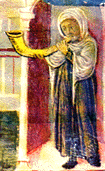
|
The Shofar
Italy, c. 1485 |
There was disagreement between the Talmudic Rabbis concerning the middle sound of a sequence of three calls as to whether it should be like sighing or weeping.12. To play safe they included all possibilities in different permutations. That is why the sequences are long, and why we have series, which vary just slightly from each other. It is traditional that the last note blown is a  (Teki'ah G'dolah), a big Teki'ah, which is a long note. While the Ashkenazim separate their notes, the Sephardim tend to run them into each other to make more of a wailing sound. Different communities sometimes preserve their own method of blowing.
(Teki'ah G'dolah), a big Teki'ah, which is a long note. While the Ashkenazim separate their notes, the Sephardim tend to run them into each other to make more of a wailing sound. Different communities sometimes preserve their own method of blowing.
Whereas in most  (mitsvot) commandments, one has to actually perform something, with regard to the Shofar, the mitsvah is not to blow it, but to hear it blown. Many Jews take great care that they and their children are in the service at the time when the Shofar is sounded. The Shofar sound is not beautiful music so much as an eerie awe-inspiring sound, which seems to bridge the centuries. The name Yom Teru'ah shows that the Shofar has been used since early Biblical times. See above NAMES OF THE FESTIVAL.
(mitsvot) commandments, one has to actually perform something, with regard to the Shofar, the mitsvah is not to blow it, but to hear it blown. Many Jews take great care that they and their children are in the service at the time when the Shofar is sounded. The Shofar sound is not beautiful music so much as an eerie awe-inspiring sound, which seems to bridge the centuries. The name Yom Teru'ah shows that the Shofar has been used since early Biblical times. See above NAMES OF THE FESTIVAL.
(11.) Rosh Hashanah 4, 9. (12.) Rosh Hashanah 34a.
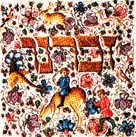
|
Zochrenu, (Remember us)
Machzor, Italy, c. 1485 |
In the  (Musaf ), Additional service for Rosh Hashanah there are three special sections which include the sounding of the Shofar. These three sections are known as the
(Musaf ), Additional service for Rosh Hashanah there are three special sections which include the sounding of the Shofar. These three sections are known as the  (Malchuyot), Kingship of God,
(Malchuyot), Kingship of God,  (Zichronot), Remembrance, and
(Zichronot), Remembrance, and  (Shofarot) Ram's Horns. They are said to date back to the 3rd century and were composed by Rav.13. These three sections follow the same basic pattern, but each have the theme of their title. They each contain a prayer, ten quotations and some singing, all based on the theme. For more on Malchuyot see KINGSHIP OF GOD.. The Zichronot ask God to remember us, the Patriarchs and His covenant with us, and so forgive us. And we, of course, should remember our side of the covenant and obey His laws. The Shofarot section is about occasions when the Shofar was or will be blown, and also with those events connected to the Shofar. Many of these are mentioned by Saadiah, see REASONS FOR THE SHOFAR.
(Shofarot) Ram's Horns. They are said to date back to the 3rd century and were composed by Rav.13. These three sections follow the same basic pattern, but each have the theme of their title. They each contain a prayer, ten quotations and some singing, all based on the theme. For more on Malchuyot see KINGSHIP OF GOD.. The Zichronot ask God to remember us, the Patriarchs and His covenant with us, and so forgive us. And we, of course, should remember our side of the covenant and obey His laws. The Shofarot section is about occasions when the Shofar was or will be blown, and also with those events connected to the Shofar. Many of these are mentioned by Saadiah, see REASONS FOR THE SHOFAR.
(13.) Leviticus Rabba 29, 1.
When Rosh Hashanah falls on Shabbat, the question is raised whether or not it is permitted to blow the Shofar. The custom when the Temple stood was to sound it on Shabbat, but only in the Temple area. Musical instruments were played to accompany singing on the Sabbath. Psalm 92, entitled the psalm for the Sabbath Day, instructs us to play a number of instruments to praise God. The early ruling in the 1st Century CE was that If the festive day of New Year fell on a Sabbath, they used to blow the Shofar in the temple but not in the provinces: after the destruction of the temple, Rabban Johanan ben Zaccai ordained that it should be blown [on Sabbath] in every place where there was a Beth Din. 14. Later in Talmudic times even this was stopped.
The present custom among the Orthodox is to follow the view of Rabbah, and not to sound the Shofar on Shabbat. This is not because it is wrong to blow a musical instrument, but because if it was blown, someone might think that it had been carried to Synagogue or that one might be tempted to carry it, and carrying is forbidden. 15. In most Reform and Liberal Synagogues they regard it as more important that the congregation hear the sound and be encouraged to repent than the slight risk that the Ba'al Teki'ah (Shofar Blower) might be tempted to carry it, therefore it is blown on Shabbat.
(14.) Rosh Hashanah 4, 1. (15.) Rosh Hashanah 29b.

When making Kiddush on the eve of New Year, some families have a round Challah to signify that a new year has come round again. When they eat the challah some dip it in honey instead of salt. Many have the custom of dipping apple into honey and eating it and saying to each other May you have a sweet and fruitful new year!16. Honey cake is often eaten at Rosh Hashanah for the same reason. These customs may also have developed because autumn is both the time for picking apples and also for collecting honey before the winter.
(16.) Isserles in S.A. Orach Chayim 583, 1. For other foods see K'ritot 6a.
Many people send out New Year greetings cards. On these the message is usually:


 (L'Shanah Tovah v'tikatevu b'sefer hachayim.) Meaning "Happy New Year and may you be inscribed in the Book of Life!" This is based on a Talmudic passage: R. Kruspedai said in the name of R. Johanan: Three books are opened [in heaven] on New Year, one for the thoroughly wicked, one for the thoroughly righteous, and one for the intermediate. The thoroughly righteous are forthwith inscribed definitively in the book of life; the thoroughly wicked are forthwith inscribed definitively in the book of death; the doom of the intermediate is suspended from New Year till the Day of Atonement; if they deserve well, they are inscribed in the book of life; if they do not deserve well, they are inscribed in the book of death. 17. As many no longer take such a simplistic view of judgement, it is more usual to find that people just say to each other:
(L'Shanah Tovah v'tikatevu b'sefer hachayim.) Meaning "Happy New Year and may you be inscribed in the Book of Life!" This is based on a Talmudic passage: R. Kruspedai said in the name of R. Johanan: Three books are opened [in heaven] on New Year, one for the thoroughly wicked, one for the thoroughly righteous, and one for the intermediate. The thoroughly righteous are forthwith inscribed definitively in the book of life; the thoroughly wicked are forthwith inscribed definitively in the book of death; the doom of the intermediate is suspended from New Year till the Day of Atonement; if they deserve well, they are inscribed in the book of life; if they do not deserve well, they are inscribed in the book of death. 17. As many no longer take such a simplistic view of judgement, it is more usual to find that people just say to each other:  (L'shanah Tovah) A Happy New Year!
(L'shanah Tovah) A Happy New Year!
(See also UN'TANEH TOKEF. )
(17.) Rosh Hashanah 16b.
For Rosh Hashanah and Yom Kippur the predominant colour in Synagogue is white. The scroll covers and the Ark curtain are changed to white. The Rabbi and Cantor usually wear white, and in some synagogues many of the congregation also do the same. The flowers arrangements are also usually white. Some see the wearing of white to show our desire to seek forgiveness of sins as it says: Though your sins be as scarlet, they shall be as white as snow.18. As the white garment that is traditionally worn is the Kittel (Burial Gown) some say that it shows our readiness to be judged even if it means death. And others say that in times past the Kittel was their finest garment and so it was worn on all festivals.
(18.) Isaiah 1, 18.
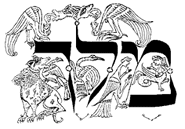
|
The word Melech from
a 13th Cent. Machzor. |
One of the themes which can be found running through the prayers on Rosh Hashanah is that of the Kingship of God. One of the three sections round the blowing of the Shofar is called Malchuyot (Divine Kingship). Some prayers on the day are altered to emphasise this. For example the end of the third blessing in the Amidah ends ha-melech ha-kadosh (the Holy King) instead of the usual ha-el ha-kadosh (the Holy God). In the Kaddish during the Penitential days, the word l'ela which means beyond, is repeated. This implies that God is very much over us ruling and judging us. This emphasis on the Kingship of God may possibly have been influenced by the Babylonian custom of parading images of their gods through the streets with crowns on their heads. We would never try to make an image of God, but we can declare Him to be King. As mentioned above, Sadiah Gaon's first reason for blowing the Shofar was that it was like the fanfare of trumpets at a royal coronation.
Un'taneh Tokef, (Let us recount the power), a prayer recited on New Year and Day of Atonement, is recognised as one of the most important prayers of New Year and is often sung with great emotion. A legend 19. attributes the prayer to Rabbi Amram of Mayence, 10th century CE, who was ordered by the Archbishop to convert to Christianity. He asked for three days to reply. When at the end of this time he was summoned to give his reply, he said that he should not have asked for time, but that he had sinned by not refusing immediately. For not coming and saying this right away, he asked that his tongue should be cut out and his feet maimed. The thwarted archbishop ordered this to be carried out. But on Rosh Hashanah, then dying from his wounds, recited the prayer in synagogue and then expired. After his death he appeared to Kalonymos ben Meshulam, a noted Ashkenazi poet, and dictated the text for posterity.
The prayer speaks of God's judgement on Rosh Hashanah and that the fate of all individuals is decided on this day. It says that God decides who will die in the coming year and what form the death will take. It lists the various methods of death as if to scare people into repenting. The prayer does not accord with the views of many 21st century Jews, because of it's references to predestination and to the belief that death is a punishment for sin. Many Jews now believe that the High Holy Days are a time for self-judgement in the light of God's teachings.
There is one sentence which changes the whole tenor of the rest of the prayer, which says that Repentance, Prayer and Charity (tsedakah) annul the severity of the judgement. This links with the idea that God opens up ledgers on Rosh Hashanah but waits to seal them until the end of Yom Kippur, (see NEW YEAR GREETINGS.) letting us have ten days for our repentance, prayers for forgiveness and good deeds. This accounts for the fact that many charity appeals are made at this season. These charities are helping us by giving us the opportunity to practice Tsedakah and so soften God's judgement upon us.
(19.) Or Zarua #276.
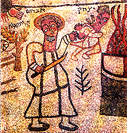
|
Akedah. Mosaic in
6th Cent. Synagogue. |
The Torah reading for the second day of Rosh Hashanah is the story contained in Genesis chapter 22, which describes how God ordered Abraham to go and sacrifice his son, Isaac on a certain hill top. In Hebrew this is known as the  (Akedah), Binding of Isaac. This story is closely linked to Rosh Hashanah because of the mention of ram's horns. But the story also describes Abraham's willingness to obey God, even to the extent of sacrificing his son. God stops him at the last moment. It is read on the festival to remind us both of our duty to obey God and of the necessity for us to give up some of our dearest desires or loves in order to do what God wants.
(Akedah), Binding of Isaac. This story is closely linked to Rosh Hashanah because of the mention of ram's horns. But the story also describes Abraham's willingness to obey God, even to the extent of sacrificing his son. God stops him at the last moment. It is read on the festival to remind us both of our duty to obey God and of the necessity for us to give up some of our dearest desires or loves in order to do what God wants.
The Akedah has been associated with the New Year since the age of the Babylonian Talmud, when it was read on the second day.20. That the story was regarded as very important, can be seen from the number of early Synagogues found where the story is depicted in a prominent position. In many congregations, which keep only one day Rosh Hashanah, they read the Akedah on that day.
(20.) Megillah 31a.
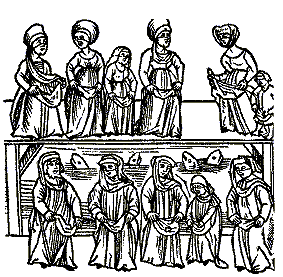
|
Tashlich, Shaking garments.
Germany, c. 1530. |
On the afternoon of Rosh Hashanah on the first day (providing it is not a Saturday), there is a tradition for Jews to gather by streams of running water or by the sea and symbolically cast their sins upon the waters. This ceremony is called  (Tashlich), meaning casting away. During this ceremony they shake either the hems of their garments or their pockets over the water, as if shaking off the sins which were gathered there. Some scatter crumbs to symbolise their sins. This ceremony is based on the verse: And you will cast all their sins into the depths of the sea,21. from the first Hebrew word of which it's name is taken.
(Tashlich), meaning casting away. During this ceremony they shake either the hems of their garments or their pockets over the water, as if shaking off the sins which were gathered there. Some scatter crumbs to symbolise their sins. This ceremony is based on the verse: And you will cast all their sins into the depths of the sea,21. from the first Hebrew word of which it's name is taken.
Whether this ceremony is a valid religious experience depends on the attitude of mind of the person performing it. If they feel that they can free themselves from sin by simply performing this piece of ritual, then it is little more than an empty superstitious practice. But if they perform it as a sign that they are ready to begin the long journey of repentance and atonement, then it might have some value. The earliest mention of Tashlich was in the late 14th century CE, when Rabbi Jacob Moellin in Germany tried to discourage its observance, because it was linked with superstitious beliefs. The practice began among the Ashkenazim and it spread to the Sephardim rather later.
(21.) Micah 7, 19.
 (Rosh Hashanah), the Jewish New Year falls on the first of Tishri, which is the seventh month of the Jewish calendar. Originally, Rosh Hashanah was just a small part of the Autumn harvest festival. The name Rosh Hashanah was not given to the day until after the Bible was completed. 1. Later, when it became a separate festival it rose in importance. It is now one of the Yamim Nora'im (the Awesome Days), it is also referred to in English as part of the High Holy Days. It is therefore one of the days where you may expect to find all religious Jews in Synagogue. For a further explanation please see THE CALENDAR
(Rosh Hashanah), the Jewish New Year falls on the first of Tishri, which is the seventh month of the Jewish calendar. Originally, Rosh Hashanah was just a small part of the Autumn harvest festival. The name Rosh Hashanah was not given to the day until after the Bible was completed. 1. Later, when it became a separate festival it rose in importance. It is now one of the Yamim Nora'im (the Awesome Days), it is also referred to in English as part of the High Holy Days. It is therefore one of the days where you may expect to find all religious Jews in Synagogue. For a further explanation please see THE CALENDAR (Yom Kippur), the Day of Atonement. It is therefore a very serious day, when we begin the long process of admitting our wrong doings, repenting of them and seeking forgiveness for them.
(Yom Kippur), the Day of Atonement. It is therefore a very serious day, when we begin the long process of admitting our wrong doings, repenting of them and seeking forgiveness for them. (Yom T'ruah).2. = The day of the sounding of the
(Yom T'ruah).2. = The day of the sounding of the  (Yom Hadin.) = The day of Judgement. (see also
(Yom Hadin.) = The day of Judgement. (see also  (Yom Hazikaron) 4. =The Day of Memorial (or remembrance). It is for us to remember our past faults and for God to remember us with mercy and forgive us.
(Yom Hazikaron) 4. =The Day of Memorial (or remembrance). It is for us to remember our past faults and for God to remember us with mercy and forgive us.

 (Shofar), horn on the first day of each month. But on the first of Tishri, which was a very special month filled with holy days, there was a series of Shofar calls. The Shofar itself could be taken from any clean animal, but they avoided bullocks lest it should remind God of our greatest sin, that concerning the golden calf. It was therefore usually a ram's horn, and was linked with the ram caught by it's horns at the time of the sacrifice of Isaac.5. The Shofar has to be curved to symbolise our willingness to bend and repent before God and not be unbending or stiff-necked.6.
(Shofar), horn on the first day of each month. But on the first of Tishri, which was a very special month filled with holy days, there was a series of Shofar calls. The Shofar itself could be taken from any clean animal, but they avoided bullocks lest it should remind God of our greatest sin, that concerning the golden calf. It was therefore usually a ram's horn, and was linked with the ram caught by it's horns at the time of the sacrifice of Isaac.5. The Shofar has to be curved to symbolise our willingness to bend and repent before God and not be unbending or stiff-necked.6. (Teki'ah),
(Teki'ah),  (Teru'ah), and
(Teru'ah), and  (Shevarim).(or Yevavot).The order of the blasts consists of three sets of three each. the length of a teki'ah is equal to three teru'ahs, and the length of a teru'ah to three yevavoth. 11.
(Shevarim).(or Yevavot).The order of the blasts consists of three sets of three each. the length of a teki'ah is equal to three teru'ahs, and the length of a teru'ah to three yevavoth. 11.
 (Teki'ah G'dolah), a big Teki'ah, which is a long note. While the
(Teki'ah G'dolah), a big Teki'ah, which is a long note. While the  (mitsvot) commandments, one has to actually perform something, with regard to the Shofar, the mitsvah is not to blow it, but to hear it blown. Many Jews take great care that they and their children are in the service at the time when the Shofar is sounded. The Shofar sound is not beautiful music so much as an eerie awe-inspiring sound, which seems to bridge the centuries. The name Yom Teru'ah shows that the Shofar has been used since early Biblical times. See above
(mitsvot) commandments, one has to actually perform something, with regard to the Shofar, the mitsvah is not to blow it, but to hear it blown. Many Jews take great care that they and their children are in the service at the time when the Shofar is sounded. The Shofar sound is not beautiful music so much as an eerie awe-inspiring sound, which seems to bridge the centuries. The name Yom Teru'ah shows that the Shofar has been used since early Biblical times. See above 
 (Musaf ), Additional service for Rosh Hashanah there are three special sections which include the sounding of the Shofar. These three sections are known as the
(Musaf ), Additional service for Rosh Hashanah there are three special sections which include the sounding of the Shofar. These three sections are known as the  (Malchuyot), Kingship of God,
(Malchuyot), Kingship of God,  (Zichronot), Remembrance, and
(Zichronot), Remembrance, and  (Shofarot) Ram's Horns. They are said to date back to the 3rd century and were composed by Rav.13. These three sections follow the same basic pattern, but each have the theme of their title. They each contain a prayer, ten quotations and some singing, all based on the theme. For more on Malchuyot see
(Shofarot) Ram's Horns. They are said to date back to the 3rd century and were composed by Rav.13. These three sections follow the same basic pattern, but each have the theme of their title. They each contain a prayer, ten quotations and some singing, all based on the theme. For more on Malchuyot see 


 (L'Shanah Tovah v'tikatevu b'sefer hachayim.) Meaning "Happy New Year and may you be inscribed in the Book of Life!" This is based on a
(L'Shanah Tovah v'tikatevu b'sefer hachayim.) Meaning "Happy New Year and may you be inscribed in the Book of Life!" This is based on a 

 (Akedah), Binding of Isaac. This story is closely linked to Rosh Hashanah because of the mention of ram's horns. But the story also describes Abraham's willingness to obey God, even to the extent of sacrificing his son. God stops him at the last moment. It is read on the festival to remind us both of our duty to obey God and of the necessity for us to give up some of our dearest desires or loves in order to do what God wants.
(Akedah), Binding of Isaac. This story is closely linked to Rosh Hashanah because of the mention of ram's horns. But the story also describes Abraham's willingness to obey God, even to the extent of sacrificing his son. God stops him at the last moment. It is read on the festival to remind us both of our duty to obey God and of the necessity for us to give up some of our dearest desires or loves in order to do what God wants.
 (Tashlich), meaning casting away. During this ceremony they shake either the hems of their garments or their pockets over the water, as if shaking off the sins which were gathered there. Some scatter crumbs to symbolise their sins. This ceremony is based on the verse: And you will cast all their sins into the depths of the sea,21. from the first Hebrew word of which it's name is taken.
(Tashlich), meaning casting away. During this ceremony they shake either the hems of their garments or their pockets over the water, as if shaking off the sins which were gathered there. Some scatter crumbs to symbolise their sins. This ceremony is based on the verse: And you will cast all their sins into the depths of the sea,21. from the first Hebrew word of which it's name is taken.